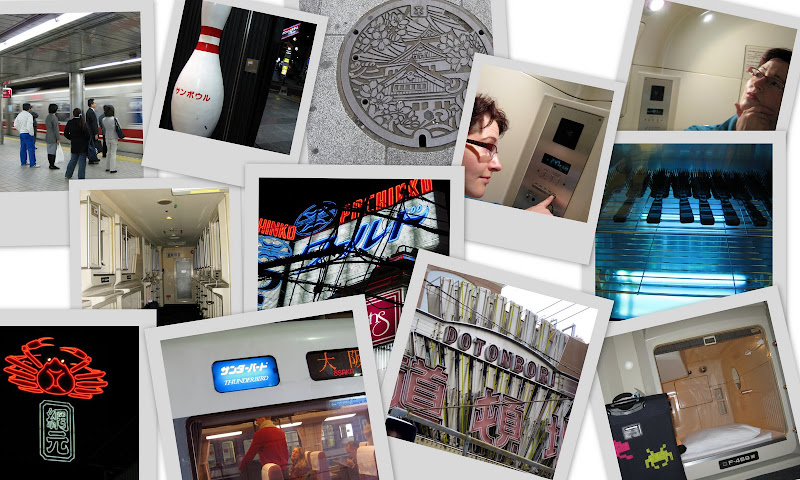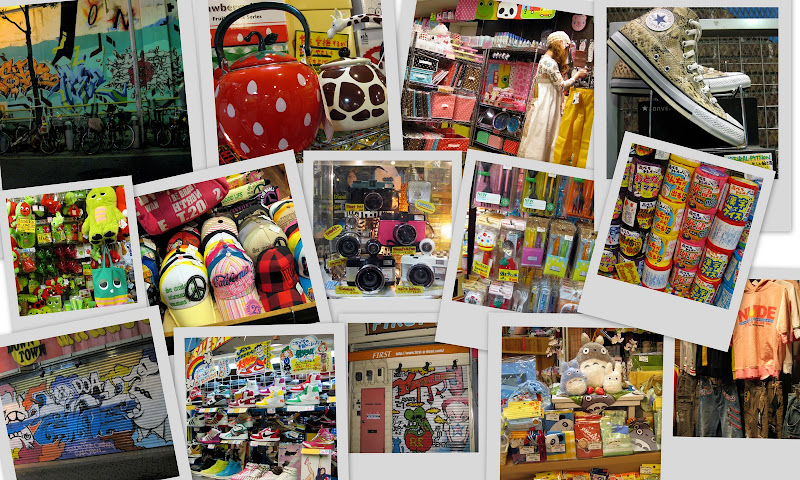Just checking… you guys know you can click on the Polaroid collages, and it will take you to my full Flickr album for that post, where you can see full-sized versions of the little pictures, right? Right?? Sorry for insulting any HaXX0rz in the crowd, but my Mum is reading this, so I had to make sure I wasn’t uploading gigs of images for nothing.
Many people I’ve spoken to (Skye included) seemed nonplussed about Osaka, including people I’ve met on the road. Personally, I liked it a lot. It had a relaxed, casual feeling that Tokyo lacked. Kind of fun, goofy, not taking itself too seriously. The streets in Amerika-mura, where I stayed at one of the few capsule hotels in Japan that will accommodate women, were bustling and covered in neon and speakers and graffiti, but not in an overwhelming way – the scale was just right, the buildings, sidewalks and streets cozy and harmonious.
It was a challenge actually finding the Capsule Hotel at Asahi Plaza. The directions start out well enough, “*By Subway Midosuji Line, Shinsaibashi station, Exit 7. Walk towards Namba, turn right at the third traffic light”, but that’s not super helpful if you don’t know what direction Namba is in, and the street signs at exit 7 aren’t going to help you orient yourself. I walked the wrong way at first, but turned around once I saw Chanel & Louis Vuitton – no hotel charging only 2800 yen a night was going to be in that neighborhood – walked back, and found the right street.
The next instruction, “go straight approximately 200 m.” was less useful. Even once you stumble upon the unassuming, poorly-labeled Asahi Plaza, the entrance on the street you are walking down is not the right one. You have to go back out the door, walk to the street, turn right, turn right again, and go in a completely different door. For n00bs who can’t read kanji, it’s confusing. I might have said, “Pass the temple on your right, then look for the gigantic, 8 foot high bowling pin on your left. You’re almost there!”. Direction writers: use landmarks, plsthx.
Once I got in and registered, however, I LOVED it. I don’t know why we don’t have these damn things in North America. My little capsule was like a house from the future. Even the font used for the capsule labels looked imported from the 24th century. Super cool with its tiny television set showing me a horribly dubbed episode of Mutant X, its brushed-steel digital alarm clock panel, its handy anti-claustrophobia round mirror and its tiny pull-down fabric screen door. Just spacious enough for one, and perfectly dark and quiet once I turned the lights out. I feel like we could solve the homelessness problem with these, somehow.
The communal bathroom was clean, with the toilet paper ends all folded neatly into little triangles – yet another strange custom in Japan. I had a key to the outer dorm door, and another key to my locker for keeping anything I couldn’t fit into my capsule. (Note: everything, including me, my huge suitcase, my backpack and gigantic shoulder-bag all fit into the capsule at once, with room to spare.) The locker also had a clean towel and pair of pyjamas. There were showers and a hot tub and laundry and vending machines and a reading area with electric outlets and comfy chairs. It was like living in residence, but on a smaller scale.
After I got settled I ventured outside to see the wonders of Amerika-mura. I’ve already written about the insane number of cyclists and bicycles parked everywhere, but there were also many takiyaki stands (will mention in next food post) and dozens of shops selling cool “America-style” clothing. Wicked shoe store with bizarre Converse and Nike sneaks for sale, an awesome hat shop, lots of hippy and Rasta themed stores.
But my favourite shop in Amerika-mura was this random store that looked tiny from the street, and appeared to sell bikes and maybe some gag gifts like rubber chickens and exploding cigars (and indeed, it did sell all of those things), but that went back and back and back like a bowling alley and displayed an unbelievable collection of… well, very cool (sugoi!) junk. Novelty cameras, novelty tea kettles, novelty toilet paper, funky rings and studs for those peculiar piercings you don’t want people to know about, motorcycle helmets, weird bleeding-edge contemporary music CDs, belt buckles, incense, toys, stickers, care bears, books, magazines, porn, cupcake-shaped forks, a gigantic 8-foot long stuffed banana in a hammock… David Lynch and Terry Gilliam very likely own stock in this store.
I’m not even scratching the surface of what was on offer in that one shop, or in Amerika-mura and the incredibly vast Namba station underground mall, which was equally cool and worth exploring (also, home to Beard Papa’s cream puffs… delectable!). I sort of want to ditch Kyoto with all its fancy ancient temples just to go back and keep browsing in Osaka. I’m sure there was some corner I missed with the Holy Grail in it…


Nice writing style. Looking forward to reading more from you.
Chris Moran
I really thought that Japan would have more people on the streets, but some of the photos you have taken seem to give lie to that! Miss you – Love, Mom
Oh, there are people here all right – it’s just that they’re concentrated highly in the large cities. My early travels were in more suburban areas, where there are fewer people.
For example, Shimo-suwa (where Stephen & Skye were living) has a population of only 23,300 people and a density of 348 persons per km². Miyajima, where I was two days ago, is rural and mountainous, only 12 sq. miles, and has a population of about 2000 people, but thousands of tourists all over it.
And that hilariously tiny rural train station I stopped at, Minami-Otari? Was in the village of Otari, population 4,122 with an extremely low density of 15.39 persons per km².
Tokyo is another beast altogether. The GTA (Greater Tokyo Area) is the world’s most populous metropolitan area, with a population of over 35 million: as compared to our GTA (Greater Toronto Area), the most populous metropolitan area in Canada and 8th largest in North America, with a population of just 5.5 million.
The cities themselves also tell a different story about density. Toronto has about 2.5 million people, with a density of 3,972/km². Tokyo has about 12.8 million people, packed very close together with a density of 5,847 /km².
Personally, I’ve failed to take photos of the worst crowds, which are entirely consisting of tourists crushing in to see the shrines, temples and castles during this “mankai” or full-cherry-blossom-time, high season for travelers. The vast volume of Chinese, Japanese and foreign tourists thronging the attractions at Himeji and here in Kyoto is driving me mad – I can’t wait to get back to the relative peace and quiet of Tokyo! Ha ha.
Miss you too Mum, love, M.A.